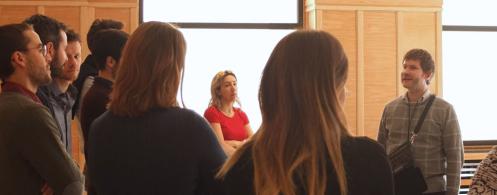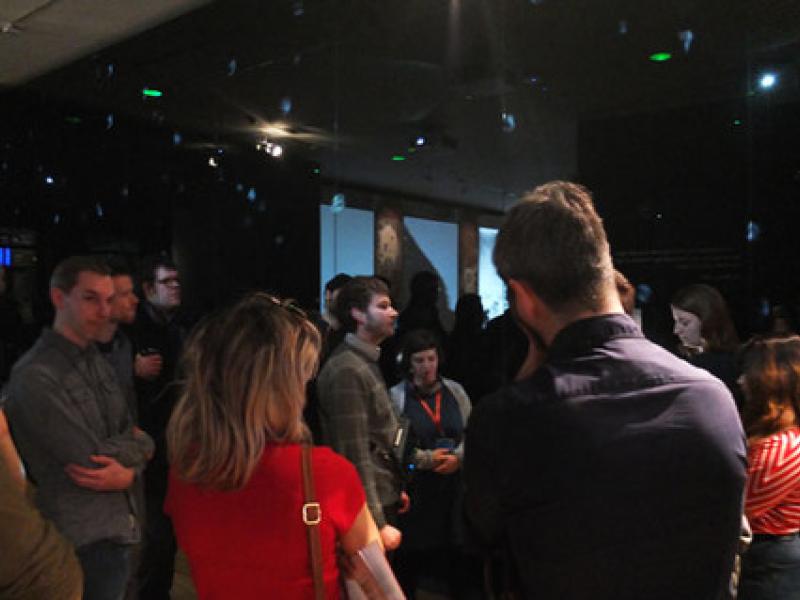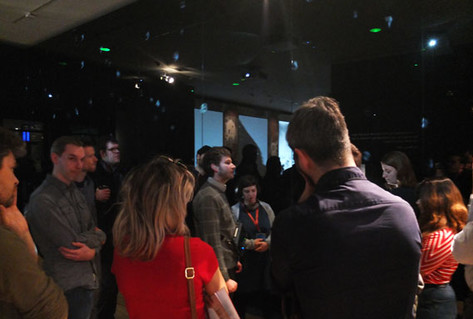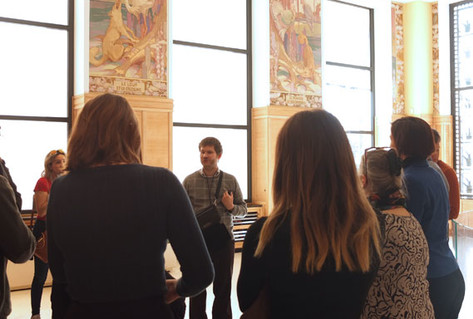
Von DAVID WILKINS
Am 26. Februar 2019 führte ich zum ersten Mal einen Rundgang durch das Haus der Europäischen Geschichte durch. Da ich völlig blind und teilweise taub bin, war dies etwas, was das Haus noch nie zuvor versucht hatte. Trotz einiger Bedenken, als wir loslegten, wurde es ein fantastisches Abenteuer. Außerdem war das Haus so freundlich, eine große Anzahl von Fotos von der Veranstaltung zu machen. Da ich keines der Objekte anfassen konnte und nur 45 Minuten Zeit hatte, konzentrierte ich mich auf einen Bereich: die Ernte der Zerstörung - eine Ausstellung, die die verheerenden Auswirkungen des Zweiten Weltkriegs auf die Zivilbevölkerung Europas erklärt. Die Geschichten werden anhand einer Auswahl persönlicher Gegenstände erzählt. Ich lernte die Beschreibungen der ausgestellten Objekte auswendig und bat die Besucher, mit Hilfe einiger Notizen zu versuchen, das Objekt zu beschreiben, bevor ich erklärte, worum es sich tatsächlich handelte.
Ich glaube, dass dies etwas ist, was das Haus häufiger tun sollte und den Besuchern die Augen für die Objekte auf einzigartige Weise öffnen würde. Im Folgenden finden Sie eine Auswahl von Kommentaren von Besuchern, die erklären, wie es war, von einem blinden Fremdenführer durch das Haus geführt zu werden.
”When I was invited to attend a tour at the House of European History and learnt that it was to be presented by someone who could not see, I was intrigued and curious as to how this would work. However, our guide, David, was a revelation. He was an eloquent speaker who in fact took advantage of his lack of sight and challenged us to question what we saw, making the whole experience much more immersive and allowing us to see the exhibits in a different light. I would definitely recommend this visit to anyone, and encourage this type of thinking to be used more widely so that museums can be accessible for everyone.”
“I participated in the lunch tour on the Harvest of Destruction that was carried out by David Wilkins. Having David as a tour guide was a wonderful experience. On the contrary of “typical” tour guides, who mainly describe the facts and the history behind the objects they are showing, David managed to bring the objects he was talking about to life, adding a great deal of emotional depth to the topic which, by itself, is already tragic. His approach, even though it was factual, was also very sensorial, making us feel involved in the tour by having to describe the objects and make us look beyond what we are seeing. David made us notice that what looked like a written letter on a piece of paper, were actually goodbye words engraved in a tree trunk by a man who was about to die in a Russian gulag. David made us look closer, deeper, forcing us to involve directly with the objects and showed us the Second World War in a new light.”
“The fact all objects he talked about were behind glass and that he could not touch them, and the fact he had to learn basically everything by heart (except for texts which he could read thanks to his machine) made the tour stand out all the more to me. Sure, there were some details which made this visit different – how David read, and how he got some very precise information sometimes wrong (such as dates) – but it wasn't really detrimental to me. It is true that you sometimes do not know if you have to tell the guide that he made a mistake; but that is also a question we ask ourselves with guides having sight! David mentioned the fact he had no sight only once, at the start of the visit – and really, that is all we needed. Other things that stood out, such as his voice and his tone were very adapted to the theme of the visit. And the most memorable thing I took back from this visit was not David's lack of sight, but the original style he adopted for his visit, his interaction with his audience, and his knowledge which was sometimes very precise: in short, nothing to do with a disability of any kind.”
”I was invited to the tour at the House of European History by David. Having visited the museum once before I was familiar with the content matter on offer but not that of the tour. My previous opinion of museum tours was that they are quite often rushed and fail to focus on all the exhibitions on display. I was therefore pleasantly surprised that the tour, on the “Harvest of Destruction”, focused on a precise point in history and gave an in depth recollection of it from a European view point, including the Russians as well as the usually Allied Forces vs Nazis portrayal. I liked the use of objects to highlight the impact of the Harvest of Destruction, as well as the use of the two quotes. As David is not sighted I felt that his delivery when he spoke to us came from the heart, you could tell that he was passionate about the subject matter he was speaking about and it showed throughout the tour.”
”I attended David Wilkins' walking tour in the House of European History and it was a great discovery. I have visited the museum several times, but on this occasion (for the first time), I took a moment to meditate on what I was looking at. This was mainly because of David's sensibility and extremely captivating way of interacting with the objects present in the museum and with the people attending the visit. I do think that a guided tour done by visually-impaired people should be implemented in the House of European History because of the great benefit it can bring to visitor's experiences.”
In conclusion, my tour — the first of its kind — received a great deal of positive feedback from visitors to the House. A few suggestions were made as to how it could be improved. However, not only did visitors find this an enriching experience but they were extremely keen to give this another go. This is again an experience many visitors feel should happen more often both in the House itself and across the rest of Europe. I cannot wait to conduct another tour of the House.




